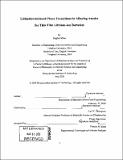Lithiation-induced phase transitions in alloying anodes for thin film lithium-ion batteries
Author(s)
Miao, Jinghui, author.
Download1373629693-MIT.pdf (16.19Mb)
Other Contributors
Massachusetts Institute of Technology. Department of Materials Science and Engineering.
Advisor
Carl V. Thompson.
Terms of use
Metadata
Show full item recordAbstract
As a result of the ever-increasing demands for miniaturized autonomous devices, high-performance batteries compatible with micro-systems have been attracting researchers' attention. Amorphous silicon (a-Si) and germanium (a-Ge), which store lithium through alloying processes rather than through intercalation, are among the top candidates as anodes for thin film Li-ion batteries. This thesis explores different types of lithiation-induced phase transitions and develops corresponding kinetic models in amorphous Si and Ge films using a framework consisting of electrochemical, structural and analytic approaches. The first section of this thesis covers the initial lithiation process of a-Si. Potentiostatic techniques reveal a kink feature in the temporal evolution of current, indicating an interface propagation mechanism for the irreversible phase transition. The rate-limiting step for propagation of the interface between unlithiated Si and the lithiated alloy is further determined to be the diffusion of Li through the lithiated phase, based on quantitative analyses of film-thickness dependence in potentiostatic tests. The second section deals with the reversible lithiation of a-Si beyond the first cycle, often assumed to be governed by simple diffusion into single-phase a-Si. We show that reversible lithiation proceeds through phase transitions between amorphous phases with different stoichiometries. Using a two-step potentiostatic technique and the Johnson-Mehl-Avrami-Kolmogorov model, it is shown that these amorphous-to-amorphous transitions occur through three-dimensional nucleation and growth processes. This conclusion is supported by TEM observations for which phase contrast is achieved through preferential high-energy electron-beam induced sputtering of Li. Instead of a complete transition at fixed voltage, reversible phase transitions in a-Si occur in a step-by-step nucleation fashion. The last section focuses on phase transitions during reversible lithiation of a-Ge using similar techniques to those used for the studies of a-Si. The only crystalline phase, Li₁₅Ge₄, is found to coexist with two amorphous alloy phases over a wide voltage range during lithiation. The formation of this crystalline phase turns is found to be highly constrained by kinetic barriers, and is very sensitive to structural evolutions such as cracking in the early cycles.
Description
Thesis: Ph. D., Massachusetts Institute of Technology, Department of Materials Science and Engineering, 2020 Cataloged from PDF version of thesis. "Due to the condition of the original material, there are unavoidable flaws in this reproduction. We have made every effort possible to provide you with the best copy available. Thank you. The images contained in this document are of the best quality available"--Disclaimer page. Includes bibliographical references (pages 114-129).
Date issued
2020Department
Massachusetts Institute of Technology. Department of Materials Science and EngineeringPublisher
Massachusetts Institute of Technology
Keywords
Materials Science and Engineering.